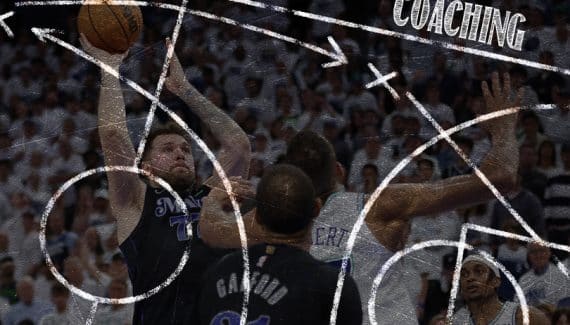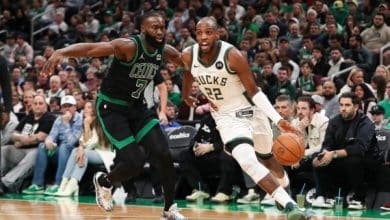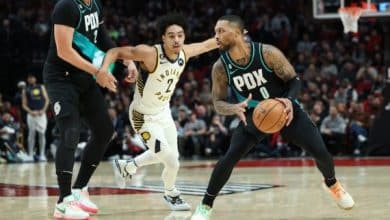
Since his first steps in the NBA, we have known that Luka Doncic is an incredible “triple threat”, but we also know that what makes him so difficult to control is his ability to read opposing defensive assists.
In the conference semi-final, the Thunder made a drastic choice to simplify their defensive choices in the face of the problems posed by the Slovenian's vision of the game. Mark Daigneault's team therefore decided to concentrate on the threat in the racket, blocking lob options as much as possible. Even if it means opening spaces from afar.
Dallas’ “Lob Duo” reactivated against the Wolves
This allowed PJ Washington to shine at 3-points, his 23 outside baskets in the series (47% success) having hurt Oklahoma City very badly, while the Gafford/Lively duo was rather well controlled, with only 45 baskets registered (on 75 shots) in six matches in total. The Wolves chose… not to choose, and to try to control both the threat on lobs and 3-point ball releases.
The result is that PJ Washington (2/12) and the other Dallas role players have much less space to shoot from afar. But the Gafford/Lively “Lob Duo” has been reactivated. In the first two matches, they have just scored 23 baskets in total (on 29 shots). This is already more than half of the previous series.
How do the Mavericks use defensive strategy to their advantage? Ben Taylor, from Thinking Basketball, rightly mentioned it, including a play pattern that the Mavs abused during Game 2.

The idea is that of a very high double screen which highlights several exploitable limits of the Wolves. Because if Jaden McDaniels is a very good defender on man, he is not as powerful as Lu Dort and he therefore has difficulty staying glued to Luka Doncic when he has to “pierce” screens, which offers more space to the Slovenian.
This double screen also brings Rudy Gobert out very high, which leaves space behind the Frenchman with an opposing interior who cuts very quickly towards the circle.
The slightest hesitation is punished
As the Wolves do not want to choose between lobs and 3-pointers, the Mavericks thus place Kyrie Irving but especially Luka Doncic in a position to use both, forcing the “tagger” (i.e. the player who helps the player who cuts into the racket) to navigate between the two options.
However, the Slovenian particularly excels in the art of punishing this in-between, playing on hesitation and his ability to hide his choices until the last moment, to punish any delay or anticipation.

Thus, each time Karl-Anthony Towns hesitated to come on the “roller”, for fear of leaving his 3-point shooter open, Luka Doncic was able to find the pass in the paint to punish the Wolves…
“Luka Magic’s” instinct to spot and punish defensive dilemmas in the opponent is quite magical. Like this sequence, approaching the last minute of Game 2, where Kyrie Irving put the Minnesota defense in rotation, the ball returning to his teammate from the “backcourt”. The latter evaluates his passing options without finding one sufficiently open, but when Kyle Anderson moves back, he sees that Jaden McDaniels' movement towards the center has left Mike Conley between Derrick Jones Jr and Kyrie Irving.
The latter “forgotten” by the opposing leader, he can be served by his conductor for an ultra valuable basket.

Will the Wolves have to make a clear choice?
But Luka Doncic's art of playing with the hesitations of the defense will hardly be better illustrated than with this sequence, six minutes from the end. The All-Star is thus served a little ahead of Kyle Anderson, after coming up from the baseline. He can therefore attack his opponent to get into the racket.
The problem is that Rudy Gobert is waiting for him, with Naz Reid to control the lob towards Daniel Gafford.

But there, with Kyle Anderson sticking him and five Wolves players surrounding him, Luka Doncic will fix Naz Reid with a fake look towards PJ Washington, in the corner. Instinctively, the 6th Man of the Year takes a step back to prepare to contest the outside shot if necessary. Which frees Daniel Gafford. And in the process, Luka Doncic rises as if he was going to shoot, which also stares at Rudy Gobert, making him take a step forward.
The Texan therefore has a small window to serve Daniel Gafford above the four-time best defender of the year, having played on the defensive dilemmas of his two opponents.
Will the Wolves continue with this strategy, banking on the revival of Anthony Edwards and their attack to counterbalance the options left to Luka Doncic on the other side of the field? Will they, like the Thunder, make a clear choice, even if it means leaving a more open option? Answer next night (02:00), during Game 3.













